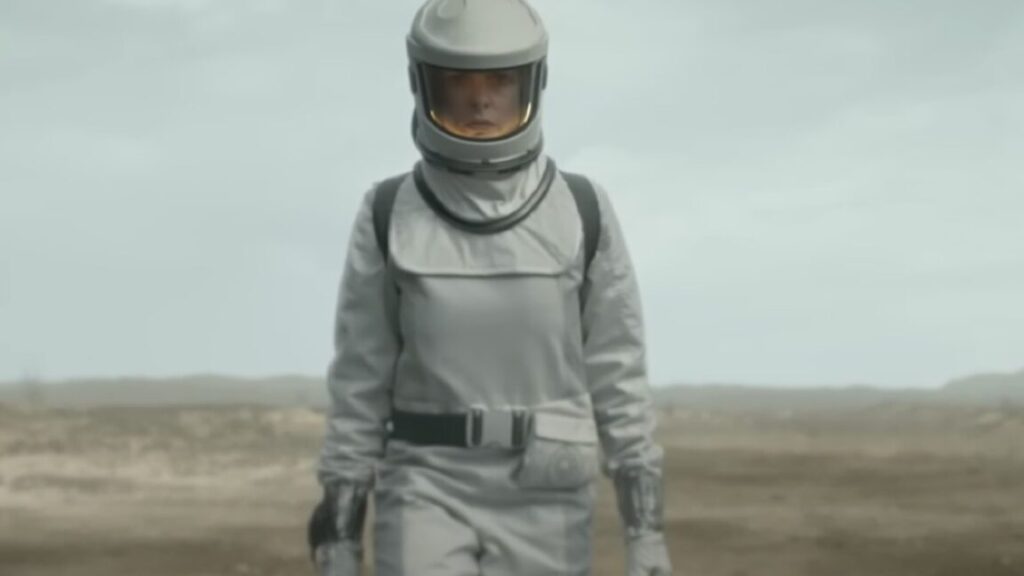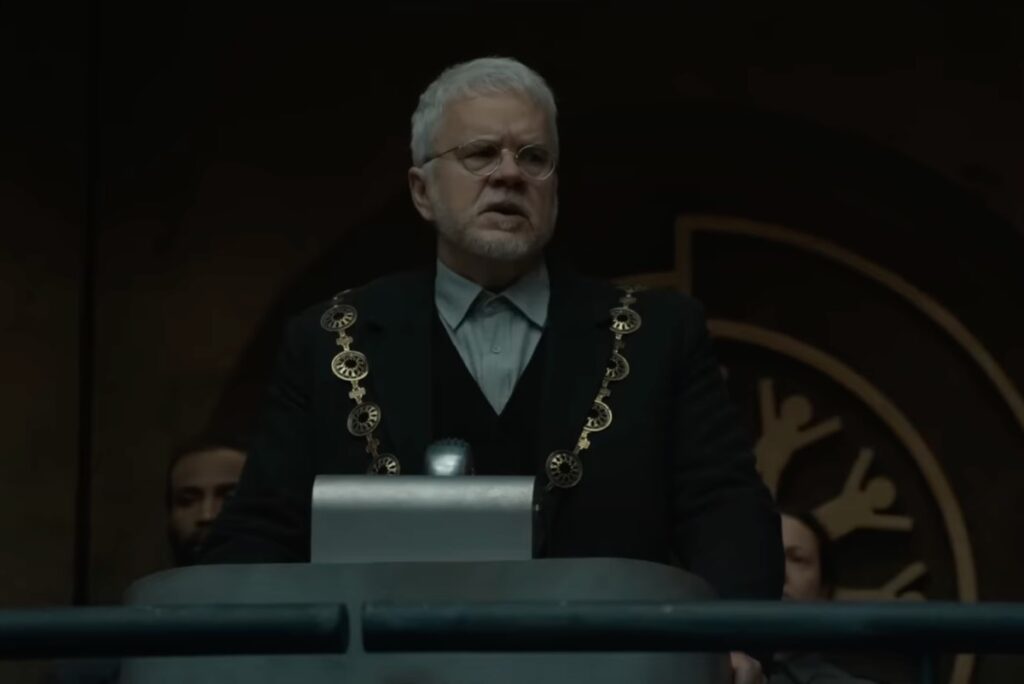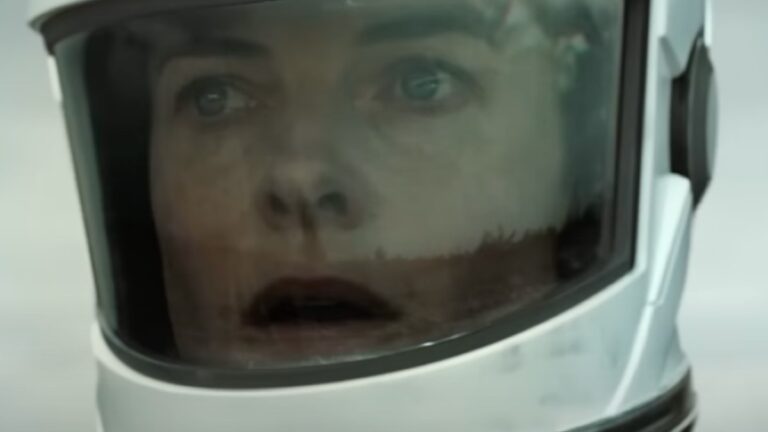Silo S2 expands its dystopian world
Ars chats with cinematographer Baz Irvine about creating a fresh look for the sophomore season.
Credit: YouTube/Apple TV+
The second season of Silo, Apple TV’s dystopian sc-fi drama, is off to a powerful start with yesterday’s premiere. Based on the trilogy by novelist Hugh Howey, was one of the more refreshing surprises on streaming television in 2023: a twist-filled combination of political thriller and police procedural set in a post-apocalyptic world. It looks like S2 will be leaning more heavily into sci-fi thriller territory, expanding its storytelling—and its striking cinematography—beyond the original silo.
(Spoilers for S1 below as well as first five minutes of S2 premiere.)
As previously reported, Silo is set in a self-sustaining underground city inhabited by a community whose recorded history only goes back 140 years, generations after the silo was built by the founders. Outside is a toxic hellscape that is only visible on big screens in the silo’s topmost level. Inside, 10,000 people live together under a pact: Anyone who says they want to “go out” is immediately granted that wish—cast outside in an environment suit on a one-way trip to clean the cameras. But those who make that choice inevitably die soon after because of the toxic environment.
Mechanical keeps the power on and life support from collapsing, and that is where we met mechanical savant Juliette Nichols (Rebecca Ferguson) at one with the giant geothermal generator that spins in the silo’s core. There were hints at what came before—relics like mechanical wristwatches or electronics far beyond the technical means of the silo’s current inhabitants, due to a rebellion 140 years ago that destroyed the silo’s records in the process. The few computers are managed by the IT department, run by Bernard Holland (Tim Robbins).
Over the course of the first season, Juliette reluctantly became sheriff and investigated the murder of her lover, George (Ferdinand Kingsley), who collected forbidden historical artifacts, as well as the murder of silo mayor Ruth Jahns (Geraldine James). Many twists ensued, including the existence of a secret group dedicated to remembering the past whose members were being systemically killed. Juliette also began to suspect that the desolate landscape seen through the silo’s camera system was a lie and there was actually a lush green landscape outside.
In the season one finale, Juliette made a deal with Holland: She would choose to go outside in exchange for the truth about what happened to George and the continued safety of her friends in Mechanical. The final twist: Juliette survived her outside excursion and realized that the dystopian hellscape was the reality, and the lush green Eden was the lie. And she learned that their silo was one of many, with a ruined city visible in the background.
That’s where the second season picks up. Apple TV+ released the footage of the first five minutes last week:
Official sneak peek for the second season of Apple TV+’s sci-fi drama Silo.
The opening battle, with all new characters, clearly took place in one of the other silos (Silo 17), and the residents desperate to break out did so only to meet their deaths. The footage ends with Juliette walking past their skeletons toward the entrance to Silo 17. We know from the official trailer that rebellion is also brewing back in her own silo as rumors spread that she is alive.
The expansion of Silo‘s world was an opportunity for cinematographer Baz Irvine (who worked on four key episodes this season) to play with lenses, color palettes, lighting, and other elements to bring unique looks to the different settings.
Ars Technica: How did you make things visually different from last season? What were your guidelines going into this for the cinematography?
Baz Irvine: There’s few different things going on. I love season one, but we were going to open it up [in S2]. We were going to introduce this new silo, so that was going to be a whole other world that had to look immediately familiar, but also completely different. We start season one with an exterior of the dystopian, future blasted planet. On the technical point, I saw two things I could do very simply. I felt that the format of season one was two to one, so not quite letterbox, not quite widescreen. When I saw the sets and I saw the art, everything the amazing art department had done, I was like, guys, this needs to be widescreen. I think at the time there was still a little bit of reticence from Apple and a few of the other streamers to commit to full widescreen, but I persuaded them.
I also changed the lenses because I wanted to keep the retro feel, the dystopian future, but retro feel. I chose slightly different lenses to give me a wider feel of view. I talked to my director, Michael Dinner, and we talked about how at times, as brilliant as season one was, it was a bit theatrical, a bit presentational. Here’s the silo, here’s the silo, here’s the silo…., So what you want to do is stop worrying about the silo. It is incredible and it’s in the back of every shot. We wanted to make it more visceral. There was going to be a lot more action. The start of episode one is a full-blown battle. Apple released the first five minutes on Apple. It actually stops at a very critical point, but you can see that it’s the previous world of the other Silo 17.
We still wanted to see the scope and the scale. As a cinematographer, you’ve got to get your head around something that’s very unusual: the Silo is vertical. When we shoot stuff, we go outside, everything’s horizontal. So as a cinematographer, you think horizontally, you frame the skyline, you frame the buildings. But in the silo, it’s all up there and it’s all down there, but it doesn’t exist. A bit of the set exists, but you have to go, oh, okay, what can I see if I point the camera up here, what will VFX brilliantly give me? What can I see down there? So that was another big discussion.
Ars Technica: When you talk about wanting to make it more visceral, what does that mean specifically in a cinematography context?
Baz Irvine: It’s just such a lovely word. Season one had an almost European aesthetic. It was a lot of very beautiful, slow developing shots. Of course it was world building. It was the first time the silo was on the screen. So as a filmmaker, you have a certain responsibility to give the audience a sense of where you are. Season two, we know where we are. Well, we don’t with the other silo, but we discover it. This role for me meant not being head of the action. So with Juliet, Rebecca Ferguson’s character, we discover what she sees with her, rather than showing it ahead of time.We’re trying to be a point of view, almost hand-held. When she’s running, we’re running with her. When she’s trying to smash her helmet, we are very much with her.
On another level, visceral for me also means responding to action—not being too prescriptive about what the camera should do, but when you see the blocking of a scene and you feel it’s going a certain way and there’s a certain energy, responding to that and getting in there. The silo, as I said, is always going to be in the background, but we’re not trying to fetishize the silo too much. We’re going to look down, we’re going to look up, we’re going to use crane moves, but just get in with the action. Just be with the people. That means slightly longer lenses, longer focal lengths at times. And from my point of view, the fall off and focus just looks so beautiful. So I think that’s what visceral means. I bet you somebody else would say something completely different.
Ars Technica: Other specific choices you made included using a muted green palette and torchlight flashlight. So there is this sense of isolation and mystery and a spooky, more immersive atmosphere.
Baz Irvine: The challenge that I could see from when I read the script is that a large part of season two is in the new Silo 17. So the new Silo 17 hasn’t been occupied for 35 years. It’s been in this dormant, strange, half-lit state. It’s overgrown with plants and ivy. Some of the references for that were what Chernobyl looked like 20 years down the line. When humanity leaves, nature just takes over. But as a counterpoint, we needed it to feel dark. Most of the electricity has gone, most of the lights have gone out. I needed to have some lighting motivation to give some sense of the shape of the Silo, so that we weren’t plummeting into darkness for the whole episode. So I came up with this idea, the overhead lights that power the silo, that light the silo, were in broken -down mode. They were in reserve power. They’d gone a bit green because that’s what the bulb technology would’ve done.
Part of the reason to do that is that when you’re cutting between two silos that were built identically, you’ve got to have something to show that you’re in a different world. Yes, it’s empty, and yes, it’s desolate and it’s eerie, and there’s strange clanking noises. But I wanted to make it very clear from a lighting point of view that they were two different places.
The other thing that you will discover in episode one, when Juliet’s character is finally working her way through the Silo 17, she has a flashlight and she breaks into an apartment. As she scans the wallshe starts to notice, oh, it’s not like her silo, there are beautiful murals and art. We really wanted to play into this idea that every silo was different. They had different groups of people potentially from different parts of the states. This silo in a way developed quite an artistic community. Murals and frescoes were very much part of this silo. It’s not something that is obvious, and it’s just the odd little scan of a flashlight that gives you this sense. But also Silo 17 is scary. It’s sort of alive, but is there life in it? That is a big question.
Ars Technica: You talk about not wanting to all be in darkness. I’m now thinking of that infamous Game of Thrones episode where the night battle footage was so dark viewers couldn’t follow what was going on. That’s clearly a big challenge for a cinematographer. Where do you find the balance?
Baz Irvine: This is the eternal dilemma for cinematographers. It’s getting notes back from the grownups going, it’s too dark,it’s too dark. Well, maybe if you were watching it in a dark room and it wasn’t bight outside, it would be fine. You have to balance things. I’ve also got Rebecca Ferguson walking around the silo, and it can’t be in so much shadow that you can’t recognize her. So there’s a type of darkness that in film world I know how to convey it. It’s very subtle. It is underexposed, but I used very soft top light. I didn’t want hard shadows. By using that light and filling in little details in the background, I can then take the lighting down. I had an amazing colorist in Company 3 in Toronto and we had a chat about how dark we could go.
We have to be very dark in places because a couple of times in this season, the electricity gets pulled altogether in the old silo as well. You can’t pull the plug and then suddenly everybody’s visible. But it is a film aesthetic that, as a cinematographer, you just learn, how dark can I go? When am I going to get in trouble? Please can I stay on the job, but make it as dark as possible? You mentioned Game of Thrones, clearly audiences have become more used to seeing imagery that I would consider more photographic, more bold generally. I try to tap into that as much as possible. If you have one character with a flashlight, then suddenly that changes everything because you point a flashlight at the surface and the light bounces back in the face. You have to use all the tools that you can.
Ars Technica: In season one there were different looks (lighting and textures) for different social hierarchies of the social hierarchies. Does that continue in season two?
Baz Irvine: I tried to push that a little bit more in season two. I loved the idea of that J.G. Ballard high rise, the rich at the top, everything inverted. The silo is crazy tall. We worked it out. It’s about a kilometer and a half.
The mechanical is the fun bit because mechanical is the bottom of the silo. Down there, we wet the walls, wet the floors, so that the more greeny, orangey colors you associate with fluorescent lights and more mechanical fixtures would reflect. You keep the light levels low because you get this lovely sheen off the walls. As you move up through the middle, where a lot of the action takes place, the lighting is more normal. I’m not really trying to push it one way or another.
Then you go up top where the judicial live, where the money and power is. You’re a lot closer to the light source because there only is this one huge light source that lights down in the silo. So up there the air is more rarefied. It’s like you’re on top of a Swiss mountain. It just feels cleaner. There’s less atmosphere, slightly bluer in light, different color temperatures on the practical lighting in offices. It’s less chaotic, more like a more modern aesthetic up there. You’ve got to be careful not to overplay it. Once you establish colors, you run with it and it just becomes second nature. It was a lot of fun to be able to demarcate—ss long as you remembered where you were, that was always the trick.
Ars Technica: What were the most notable challenges and highlights for you—without giving away anything beyond episode one.
Baz Irvine: I think the big thing about episode one is that it’s like a silent movie. Rebecca Ferguson has maybe two lines, or maybe she doesn’t actually say anything. It’s a journey of discovery, and there’s some quite scary, terrifying things that happen. There’s a lot of action. Also, we find out there’s water in Silo 17. Silo 17 is flooded. You don’t find that out until she slips and falls and you think she’s fallen to her death. From the outset knew that there would be an extensive amount of underwater, or on the surface of the water, filming that would need to take place. We had to do a massive amount of testing, looking at textures of water, what equipment we could use, how we could get the depth, the width. We built a huge tank at one of our studios in London and used Pinewood’s famous underwater tank for the fall.
Also there was the challenge of trying to do shots of that scale outside because we actually built sets. We could probably see 50 feet beyond Rebecca. We had the surface of the scorched surface, but beyond that is VFX. So we had huge blue screens and all these different cranes and things called Manitous with massive frames and had to control the sun. That was very challenging. You can really go down a very cliched path when trying to imagine what the fallout of a massive nuclear attack would look like. But we didn’t want to overplay it too much, we wanted to embed it in some sort of reality so that you didn’t suddenly feel at the start of episode one, oh my, you’re on the surface of Mars. It had to feel real, but also just completely different from the interior world of the silo.
Ars Technica: I assume that there’s a lot more exciting stuff coming in the other episodes that we can’t talk about.
Baz Irvine: There is so much exciting stuff. There’s a lot of action. The silo cafeteria, by the way, is just incredible because you have this huge screen. When I turned up, I was thinking, okay, well this is clearly going to be some big VFX blue screen. It is not. It is a projected image. The work that they did to make it feel like it was a camera mounted to the top of the silo, showing the world outside, and the different times of day—we just literally dialed in. Can I have dusk please? Can I have late afternoon with a little bit of cloud? It was such a fun toy box to play with.
New episodes of Silo S2 will premiere every Friday through January 17, 2025, on Apple TV+.
Jennifer is a senior reporter at Ars Technica with a particular focus on where science meets culture, covering everything from physics and related interdisciplinary topics to her favorite films and TV series. Jennifer lives in Baltimore with her spouse, physicist Sean M. Carroll, and their two cats, Ariel and Caliban.
Silo S2 expands its dystopian world Read More »



